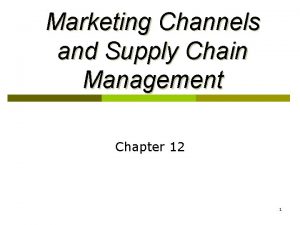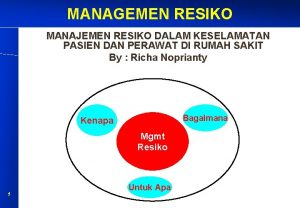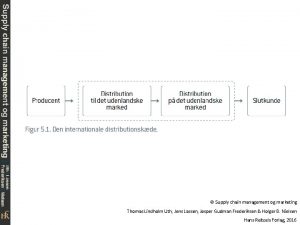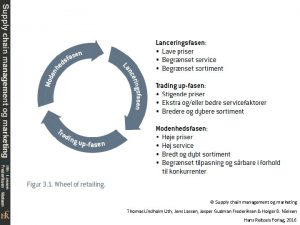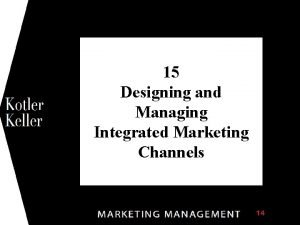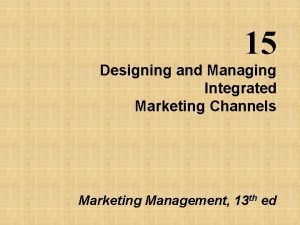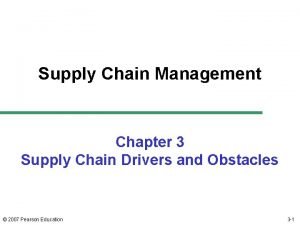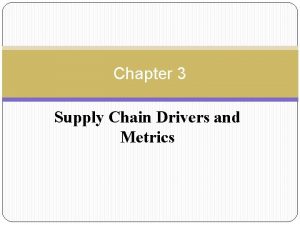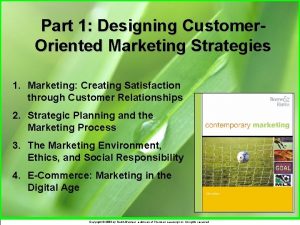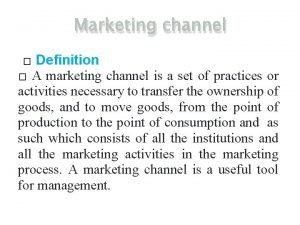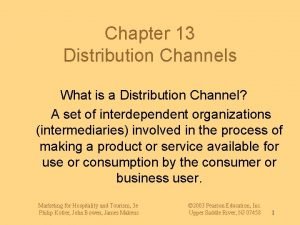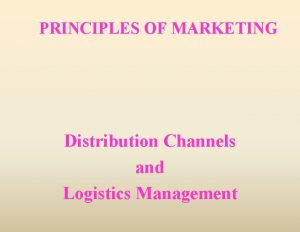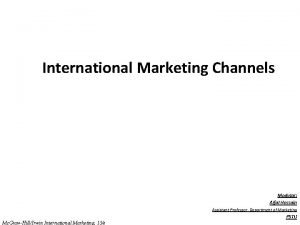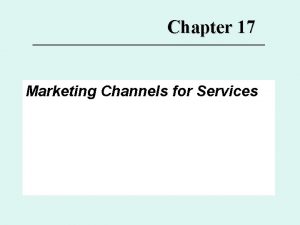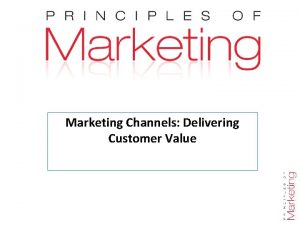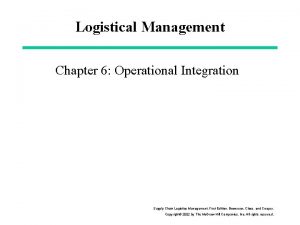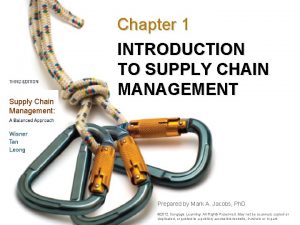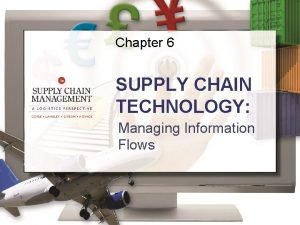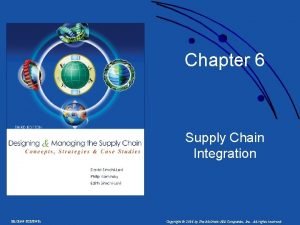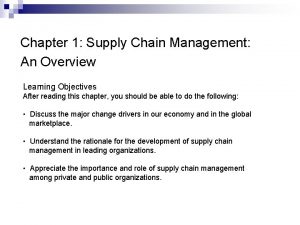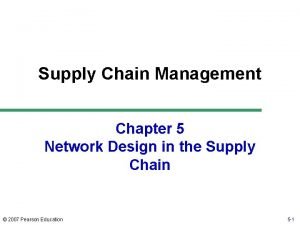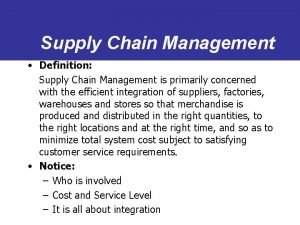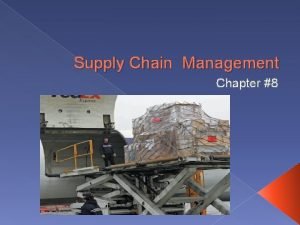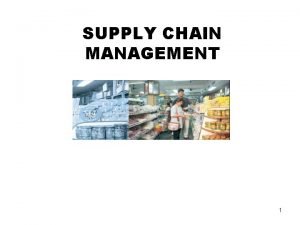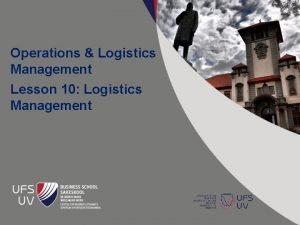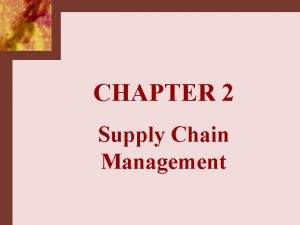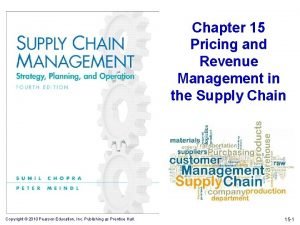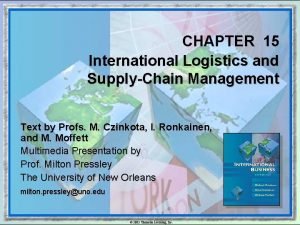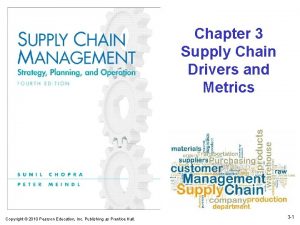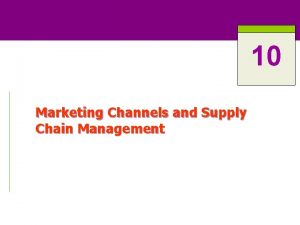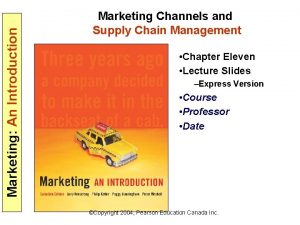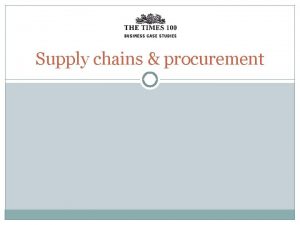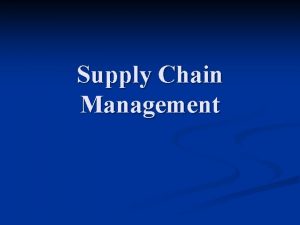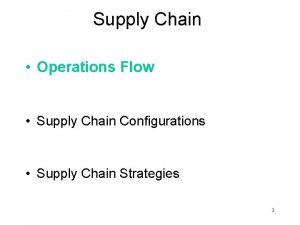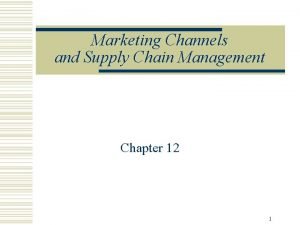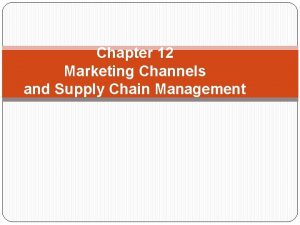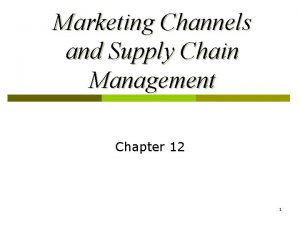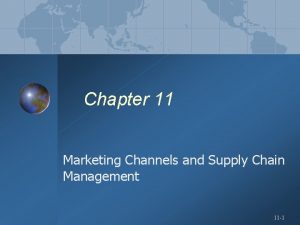Chapter 14 MARKETING CHANNELS AND SUPPLY CHAIN MANAGEMEN






























































- Slides: 62

Chapter 14 MARKETING CHANNELS AND SUPPLY CHAIN MANAGEMEN T © 2014 Cengage Learning. All Rights Reserved. May not be scanned, copied or duplicated, or posted to a publicly accessible website, in whole or in part. 1

Chapter 14 Marketing Channels and Supply Chain Management Objectives 1. Describe the types of marketing channels 2. 3. and the roles they play in marketing strategy. Outline the major channel strategy decisions. Describe the concepts of channel management, conflict, and cooperation. © 2014 Cengage Learning. All Rights Reserved. May not be scanned, copied or duplicated, or posted to a publicly accessible website, in whole or in part. 2

Chapter 14 Marketing Channels and Supply Chain Management Objectives 4. Identify and describe the different 5. 6. vertical marketing systems. Explain the roles of logistics and supply chain management in an overall distribution strategy. Identify the major components of a physical distribution system. © 2014 Cengage Learning. All Rights Reserved. May not be scanned, copied or duplicated, or posted to a publicly accessible website, in whole or in part. 3

Chapter 14 Marketing Channels and Supply Chain Management Objectives 7. Compare the major modes of 8. transportation. Discuss the role of transportation intermediaries, combined transportation modes, and warehousing in improving physical distribution. © 2014 Cengage Learning. All Rights Reserved. May not be scanned, copied or duplicated, or posted to a publicly accessible website, in whole or in part. 4

Chapter 14 Marketing Channels and Supply Chain Management Introduction ▮ Distribution - Movement of goods and services from producers to customers ▮ Marketing (distribution) channel - System of marketing institutions that enhances the: • Physical flow of goods and services • Ownership title, from producer to consumer or business user © 2014 Cengage Learning. All Rights Reserved. May not be scanned, copied or duplicated, or posted to a publicly accessible website, in whole or in part. 5

Chapter 14 Marketing Channels and Supply Chain Management Introduction ▮ Logistics - Coordinating the flow of information, goods, and services among members of the distribution channel ▮ Supply-chain management - Control of the activities of purchasing, processing, and delivery through which: • Raw materials are transformed into products and made available to final consumers © 2014 Cengage Learning. All Rights Reserved. May not be scanned, copied or duplicated, or posted to a publicly accessible website, in whole or in part. 6

Chapter 14 Marketing Channels and Supply Chain Management Introduction ▮ Physical distribution - Broad range of activities aimed at: • Efficient movement of finished goods from the end of the production line to the consumer © 2014 Cengage Learning. All Rights Reserved. May not be scanned, copied or duplicated, or posted to a publicly accessible website, in whole or in part. 7

Chapter 14 Marketing Channels and Supply Chain Management The Role of Marketing Channels in Marketing Strategy ▮ Four functions of marketing channels: • Facilitating the exchange process by reducing the number of marketplace contacts necessary to make a sale • Adjusting for discrepancies in the market’s assortment of goods and services via sorting • Standardizing exchange transactions by setting expectations for products • Facilitating searches by both buyers and sellers © 2014 Cengage Learning. All Rights Reserved. May not be scanned, copied or duplicated, or posted to a publicly accessible website, in whole or in part. 8

Chapter 14 Marketing Channels and Supply Chain Management Types of Marketing Channels ▮ Marketing intermediary - Organization that operates between producers and consumers or business users ▮ Wholesaler - Takes title to the goods it handles and then distributes these goods to: • Retailers • Other distributors • End consumers © 2014 Cengage Learning. All Rights Reserved. May not be scanned, copied or duplicated, or posted to a publicly accessible website, in whole or in part. 9

Chapter 14 Marketing Channels and Supply Chain Management Types of Marketing Channels ▮ Service firms market through short channels because they sell intangible products and need to maintain personal relationships within their channels © 2014 Cengage Learning. All Rights Reserved. May not be scanned, copied or duplicated, or posted to a publicly accessible website, in whole or in part. 10

Chapter 14 Marketing Channels and Supply Chain Management Figure 14. 1 – Alternative Marketing Channels © 2014 Cengage Learning. All Rights Reserved. May not be scanned, copied or duplicated, or posted to a publicly accessible website, in whole or in part. 11

Chapter 14 Marketing Channels and Supply Chain Management Direct Selling ▮ Direct channel - Moves goods directly from a producer to the business purchaser or ultimate user ▮ Direct selling - Strategy designed to establish direct sales contact between producer and final user © 2014 Cengage Learning. All Rights Reserved. May not be scanned, copied or duplicated, or posted to a publicly accessible website, in whole or in part. 12

Chapter 14 Marketing Channels and Supply Chain Management Direct Selling • Important option for goods that require extensive demonstrations in persuading customers to buy • Plays an important role in both B 2 B and B 2 C markets • The Internet and direct mail are important tools for direct selling © 2014 Cengage Learning. All Rights Reserved. May not be scanned, copied or duplicated, or posted to a publicly accessible website, in whole or in part. 13

Chapter 14 Marketing Channels and Supply Chain Management Channels Using Marketing Intermediaries ▮ Producer to wholesaler to retailer to consumer • The traditional channel for consumer goods • Gives small producers access to hundreds of retailers • Gives small retailers access to wholesaler’s specialized distribution skills ▮ Producer to wholesaler to business user • Industrial distributor - Intermediaries in the business market that take title to goods © 2014 Cengage Learning. All Rights Reserved. May not be scanned, copied or duplicated, or posted to a publicly accessible website, in whole or in part. 14

Chapter 14 Marketing Channels and Supply Chain Management Channels Using Marketing Intermediaries ▮ Producer to agent to wholesaler to retailer to consumer • Common in markets served by small companies • Agent performs the basic function of bringing buyer and seller together • Agent may or may not take possession of goods but does not take title © 2014 Cengage Learning. All Rights Reserved. May not be scanned, copied or duplicated, or posted to a publicly accessible website, in whole or in part. 15

Chapter 14 Marketing Channels and Supply Chain Management Channels Using Marketing Intermediaries ▮ Producer to agent to wholesaler to business user • Manufacturers’ representative - Intermediary who represents manufacturers of related but noncompeting products and receives a commission on each sale • Provides an independent sales force to contact wholesale buyers © 2014 Cengage Learning. All Rights Reserved. May not be scanned, copied or duplicated, or posted to a publicly accessible website, in whole or in part. 16

Chapter 14 Marketing Channels and Supply Chain Management Channels Using Marketing Intermediaries • Manufacturers’ representative - Agent wholesaling intermediary that represents manufacturers of related but noncompeting products and receives a commission on each sale ▮ Producer to agent to business user • Independently owned wholesaler takes title to the goods • Common in transactions with large unit sales in which transportation is a small percentage of the total cost © 2014 Cengage Learning. All Rights Reserved. May not be scanned, copied or duplicated, or posted to a publicly accessible website, in whole or in part. 17

Chapter 14 Marketing Channels and Supply Chain Management Dual Distribution ▮ Movement of products through more than one channel to reach the firm’s target market ▮ Used to maximize the firm’s coverage in the marketplace ▮ To increase the cost-effectiveness of the firm’s marketing effort • Example: Nordstrom sells through stores, catalogs, and the Internet © 2014 Cengage Learning. All Rights Reserved. May not be scanned, copied or duplicated, or posted to a publicly accessible website, in whole or in part. 18

Chapter 14 Marketing Channels and Supply Chain Management Reverse Channels ▮ Channels designed to return goods to their producers ▮ Gained increased importance with: • Rising prices for raw materials • Increasing availability of recycling facilities • The passage of additional antipollution conservation laws ▮ Used for recalls and repairs © 2014 Cengage Learning. All Rights Reserved. May not be scanned, copied or duplicated, or posted to a publicly accessible website, in whole or in part. 19

Chapter 14 Marketing Channels and Supply Chain Management Table 14. 1 – Factors Influencing Marketing Channel Strategies © 2014 Cengage Learning. All Rights Reserved. May not be scanned, copied or duplicated, or posted to a publicly accessible website, in whole or in part. 20

Chapter 14 Marketing Channels and Supply Chain Management Determining Distribution Intensity ▮ Intensive distribution - Distribution of a product through all available channels ▮ Selective distribution - Distribution of a product through a limited number of channels ▮ Exclusive Distribution - Distribution of a product through a single wholesaler or retailer in a specific geographic region © 2014 Cengage Learning. All Rights Reserved. May not be scanned, copied or duplicated, or posted to a publicly accessible website, in whole or in part. 21

Chapter 14 Marketing Channels and Supply Chain Management Legal Problems of Exclusive Distribution ▮ Exclusive dealing agreement prohibits a marketing intermediary from handling competing products ▮ Closed sales territories - Restrict their distributors to certain geographic regions ▮ Tying agreements - Arrangement that requires a marketing intermediary to carry items other than those they want to sell © 2014 Cengage Learning. All Rights Reserved. May not be scanned, copied or duplicated, or posted to a publicly accessible website, in whole or in part. 22

Chapter 14 Marketing Channels and Supply Chain Management Who Should Perform Channel Functions? ▮ A member of the channel must perform certain central marketing functions ▮ Responsibilities of the different members may vary ▮ An independent intermediary earns a profit in exchange for providing services to manufacturers and retailers © 2014 Cengage Learning. All Rights Reserved. May not be scanned, copied or duplicated, or posted to a publicly accessible website, in whole or in part. 23

Chapter 14 Marketing Channels and Supply Chain Management Who Should Perform Channel Functions? ▮ An intermediary must provide better service at lower costs than manufacturers or retailers can provide for themselves © 2014 Cengage Learning. All Rights Reserved. May not be scanned, copied or duplicated, or posted to a publicly accessible website, in whole or in part. 24

Chapter 14 Marketing Channels and Supply Chain Management Channel Management and Leadership ▮ Keys to successful management of channel relationships include the development of high levels of: • Coordination • Commitment • Trust between channel members © 2014 Cengage Learning. All Rights Reserved. May not be scanned, copied or duplicated, or posted to a publicly accessible website, in whole or in part. 25

Chapter 14 Marketing Channels and Supply Chain Management Channel Management and Leadership ▮ Channel captain - Dominant and controlling member of a marketing channel • Example: Kroger is a channel captain in the grocery industry © 2014 Cengage Learning. All Rights Reserved. May not be scanned, copied or duplicated, or posted to a publicly accessible website, in whole or in part. 26

Chapter 14 Marketing Channels and Supply Chain Management Channel Conflict ▮ Horizontal conflict • Disagreements among channel members at the same level ▮ Vertical conflict • Occurs among members at different levels of the channel © 2014 Cengage Learning. All Rights Reserved. May not be scanned, copied or duplicated, or posted to a publicly accessible website, in whole or in part. 27

Chapter 14 Marketing Channels and Supply Chain Management Channel Conflict ▮ The gray market • Gray goods - Products manufactured abroad under license from a U. S. firm and then sold in: • The U. S. market in competition with that firm’s own domestic output © 2014 Cengage Learning. All Rights Reserved. May not be scanned, copied or duplicated, or posted to a publicly accessible website, in whole or in part. 28

Chapter 14 Marketing Channels and Supply Chain Management Achieving Channel Cooperation ▮ Best achieved when all members of channel see themselves as equal components of the same organization ▮ Channel captain should provide this leadership © 2014 Cengage Learning. All Rights Reserved. May not be scanned, copied or duplicated, or posted to a publicly accessible website, in whole or in part. 29

Chapter 14 Marketing Channels and Supply Chain Management Vertical Marketing Systems ▮ Designed to improve distribution efficiency and cost-effectiveness by: • Integrating various functions throughout the distribution chain ▮ Rely on forward or backward integration • Forward integration - Firm attempts to control downstream distribution • Backward integration - Manufacturer attempts to gain greater control over inputs to production process © 2014 Cengage Learning. All Rights Reserved. May not be scanned, copied or duplicated, or posted to a publicly accessible website, in whole or in part. 30

Chapter 14 Marketing Channels and Supply Chain Management Vertical Marketing Systems ▮ Benefits • Improves chances for controlling and coordinating the steps in the distribution or production process • May lead to the development of economies of scale that ultimately saves money • May let a manufacturer expand into profitable new businesses © 2014 Cengage Learning. All Rights Reserved. May not be scanned, copied or duplicated, or posted to a publicly accessible website, in whole or in part. 31

Chapter 14 Marketing Channels and Supply Chain Management Vertical Marketing Systems ▮ Disadvantages • Involves some costs • Marketers lose some flexibility ▮ Marketers have developed three categories of VMSs • Corporate systems • Administered systems • Contractual systems © 2014 Cengage Learning. All Rights Reserved. May not be scanned, copied or duplicated, or posted to a publicly accessible website, in whole or in part. 32

Chapter 14 Marketing Channels and Supply Chain Management Corporate and Administered Systems ▮ Corporate marketing system - A single owner operates the entire marketing channel ▮ Administered marketing system - Achieves channel coordination when a dominant channel member exercises its power © 2014 Cengage Learning. All Rights Reserved. May not be scanned, copied or duplicated, or posted to a publicly accessible website, in whole or in part. 33

Chapter 14 Marketing Channels and Supply Chain Management Contractual Marketing Systems ▮ Coordinates channel activities through formal agreements among participants ▮ Wholesaler-sponsored voluntary chain • A wholesaler has formal agreement with retailers to use a common name and to purchase the wholesaler’s goods • Example: IGA Food Stores © 2014 Cengage Learning. All Rights Reserved. May not be scanned, copied or duplicated, or posted to a publicly accessible website, in whole or in part. 34

Chapter 14 Marketing Channels and Supply Chain Management Contractual Systems ▮ Retail cooperative • Retailers establish a shared wholesaling operation to help them compete with chains ▮ Franchise • A wholesaler or retailer agrees to meet the operating requirements of a manufacturer or other franchiser © 2014 Cengage Learning. All Rights Reserved. May not be scanned, copied or duplicated, or posted to a publicly accessible website, in whole or in part. 35

Chapter 14 Marketing Channels and Supply Chain Management Logistics and Supply Chain Management ▮ Effective logistics requires: • Proper supply chain management • Control of the activities of purchasing, processing, and delivery • Delivery through which raw materials are transformed into products and made available to final consumers © 2014 Cengage Learning. All Rights Reserved. May not be scanned, copied or duplicated, or posted to a publicly accessible website, in whole or in part. 36

Chapter 14 Marketing Channels and Supply Chain Management Logistics and Supply Chain Management ▮ Supply chain - Complete sequence of suppliers and activities that contribute to the creation and delivery of merchandise • Begins with raw-material inputs for production • Ends with the movement of final product to customers • Takes place in two directions: upstream and downstream © 2014 Cengage Learning. All Rights Reserved. May not be scanned, copied or duplicated, or posted to a publicly accessible website, in whole or in part. 37

Chapter 14 Marketing Channels and Supply Chain Management Figure 14. 2 – The Supply Chain of a Manufacturing Company © 2014 Cengage Learning. All Rights Reserved. May not be scanned, copied or duplicated, or posted to a publicly accessible website, in whole or in part. 38

Chapter 14 Marketing Channels and Supply Chain Management Radio Frequency Identification (RFID) ▮ Technology that uses a tiny chip with identification information that can be read by a scanner using radio waves from a distance © 2014 Cengage Learning. All Rights Reserved. May not be scanned, copied or duplicated, or posted to a publicly accessible website, in whole or in part. 39

Chapter 14 Marketing Channels and Supply Chain Management Enterprise Resource Planning ▮ Software system that consolidates data from among a firm’s various business units ▮ ERP and its related software aren’t always perfect © 2014 Cengage Learning. All Rights Reserved. May not be scanned, copied or duplicated, or posted to a publicly accessible website, in whole or in part. 40

Chapter 14 Marketing Channels and Supply Chain Management Logistical Cost Control ▮ The distribution function accounts for half of a firm’s total marketing costs ▮ Businesses are reexamining each link of their supply chains to identify activities that do not add value for customers ▮ Third-party logistics firms - Specialize in handling logistical activity © 2014 Cengage Learning. All Rights Reserved. May not be scanned, copied or duplicated, or posted to a publicly accessible website, in whole or in part. 41

Chapter 14 Marketing Channels and Supply Chain Management Physical Distribution ▮ A physical distribution system contains these elements: • • • Customer service Transportation Inventory control Protective packaging and materials handling Order processing Warehousing © 2014 Cengage Learning. All Rights Reserved. May not be scanned, copied or duplicated, or posted to a publicly accessible website, in whole or in part. 42

Chapter 14 Marketing Channels and Supply Chain Management The Problem of Suboptimization ▮ Results when the managers of individual physical distribution functions attempt to: • Minimize costs, but the impact of one task on the others leads to less than optimal results ▮ Occurs when a firm introduces a new product that: • May not fit easily into its current physical distribution system ▮ Effective management of physical distribution requires cost trade-offs © 2014 Cengage Learning. All Rights Reserved. May not be scanned, copied or duplicated, or posted to a publicly accessible website, in whole or in part. 43

Chapter 14 Marketing Channels and Supply Chain Management Customer-Service Standards ▮ State the goals and define acceptable performance for the quality of service a firm expects to deliver to its customers ▮ After these standards are defined: • Designers assemble other physical distribution components to meet these standards at the lowest possible total cost © 2014 Cengage Learning. All Rights Reserved. May not be scanned, copied or duplicated, or posted to a publicly accessible website, in whole or in part. 44

Chapter 14 Marketing Channels and Supply Chain Management Customer-Service Standards ▮ Components of overall cost: • • • Transportation Warehousing Inventory control Customer service/order processing Administrative costs © 2014 Cengage Learning. All Rights Reserved. May not be scanned, copied or duplicated, or posted to a publicly accessible website, in whole or in part. 45

Chapter 14 Marketing Channels and Supply Chain Management Transportation ▮ Transportation and delivery expenses add approximately 10 percent to product costs ▮ Key to cost control is often careful management of relationships with shipping firms ▮ Freight carriers use two basic rates: • Class rate • Commodity rate or special rate © 2014 Cengage Learning. All Rights Reserved. May not be scanned, copied or duplicated, or posted to a publicly accessible website, in whole or in part. 46

Chapter 14 Marketing Channels and Supply Chain Management Classes of Carriers ▮ Common carriers - Provide transportation services as for-hire carriers to the general public ▮ Contract carriers - For-hire transporters that do not offer their services to the general public ▮ Private carriers - Transporters that provide service solely for internally generated freight © 2014 Cengage Learning. All Rights Reserved. May not be scanned, copied or duplicated, or posted to a publicly accessible website, in whole or in part. 47

Chapter 14 Marketing Channels and Supply Chain Management Major Transportation Modes ▮ Railroads • Most efficient way for moving bulky commodities over long distances; enjoying a resurgence • Intermodal operations - Combination of transport modes, to improve customer service and achieve cost advantages © 2014 Cengage Learning. All Rights Reserved. May not be scanned, copied or duplicated, or posted to a publicly accessible website, in whole or in part. 48

Chapter 14 Marketing Channels and Supply Chain Management Major Transportation Modes ▮ Motor carriers • Relatively fast and consistent service • Receives greater revenue per ton shipped • Technology (satellite communication system) has improved the efficiency of trucking © 2014 Cengage Learning. All Rights Reserved. May not be scanned, copied or duplicated, or posted to a publicly accessible website, in whole or in part. 49

Chapter 14 Marketing Channels and Supply Chain Management Major Transportation Modes ▮ Water carriers • Inland or barge lines and ocean-going, deepwater ships • Barge lines carry bulky, low-unit-value commodities such as grain, lumber, and steel • Freight rates are based on the: • Size of the vessel • Cost of fuel • Security requirements © 2014 Cengage Learning. All Rights Reserved. May not be scanned, copied or duplicated, or posted to a publicly accessible website, in whole or in part. 50

Chapter 14 Marketing Channels and Supply Chain Management Major Transportation Modes ▮ Pipelines • Efficiently transports natural gas and oil • Advantages • Low maintenance • Dependable • Disadvantages • Few locations • Accommodate only a small number of products • Relatively slow © 2014 Cengage Learning. All Rights Reserved. May not be scanned, copied or duplicated, or posted to a publicly accessible website, in whole or in part. 51

Chapter 14 Marketing Channels and Supply Chain Management Major Transportation Modes ▮ Air freight • Declining in certain market sectors • Firms are adapting • UPS is offering two less-expensive, nonguaranteed services: • UPS Air Freight Direct • UPS Air Freight Consolidated © 2014 Cengage Learning. All Rights Reserved. May not be scanned, copied or duplicated, or posted to a publicly accessible website, in whole or in part. 52

Chapter 14 Marketing Channels and Supply Chain Management Table 14. 3 – Comparison of Transport Modes © 2014 Cengage Learning. All Rights Reserved. May not be scanned, copied or duplicated, or posted to a publicly accessible website, in whole or in part. 53

Chapter 14 Marketing Channels and Supply Chain Management Freight Forwarders and Supplemental Carriers ▮ Act as transportation intermediaries that consolidate shipments to gain lower rates for their customers ▮ The customers gain advantages from the services • Lower costs on small shipments • Faster delivery service than they could achieve with their own LTL and LCL shipments © 2014 Cengage Learning. All Rights Reserved. May not be scanned, copied or duplicated, or posted to a publicly accessible website, in whole or in part. 54

Chapter 14 Marketing Channels and Supply Chain Management Freight Forwarders and Supplemental Carriers ▮ Logistics manager can ship products via a number of auxiliary, or supplemental, carriers that specialize in small shipments © 2014 Cengage Learning. All Rights Reserved. May not be scanned, copied or duplicated, or posted to a publicly accessible website, in whole or in part. 55

Chapter 14 Marketing Channels and Supply Chain Management Intermodal Coordination ▮ Piggyback - Most widely used form of intermodal coordination ▮ Birdyback service - Sends motor carriers to pick up a shipment locally and deliver that shipment to local destinations • An air carrier takes it between airports near those locations ▮ Fishyback service - Intermodal coordination system between motor carriers and water carriers © 2014 Cengage Learning. All Rights Reserved. May not be scanned, copied or duplicated, or posted to a publicly accessible website, in whole or in part. 56

Chapter 14 Marketing Channels and Supply Chain Management Warehousing ▮ Storage warehouse - Holds goods for moderate to long periods in an attempt to balance supply and demand for producers and purchasers ▮ Distribution warehouse - Assembles and redistributes goods, keeping them moving as much as possible © 2014 Cengage Learning. All Rights Reserved. May not be scanned, copied or duplicated, or posted to a publicly accessible website, in whole or in part. 57

Chapter 14 Marketing Channels and Supply Chain Management Warehousing ▮ Automated warehouse technology • Can cut distribution costs and improve customer service ▮ Warehouse locations • Main influences on choice • Warehousing and materials handling costs • Delivery costs from warehouses to customers ▮ Warehouse location affects customer service © 2014 Cengage Learning. All Rights Reserved. May not be scanned, copied or duplicated, or posted to a publicly accessible website, in whole or in part. 58

Chapter 14 Marketing Channels and Supply Chain Management Inventory Control Systems ▮ Companies must balance maintaining enough inventory to meet customer demand with: • Incurring unneeded costs for carrying excess inventory ▮ To manage cost, firms use: • Just-in-time (JIT) • RFID technology • Vendor-managed inventory (VMI) © 2014 Cengage Learning. All Rights Reserved. May not be scanned, copied or duplicated, or posted to a publicly accessible website, in whole or in part. 59

Chapter 14 Marketing Channels and Supply Chain Management Order Processing ▮ Directly affects firm’s ability to meet customer service standards ▮ Includes four major activities: • • Conducting a credit check Keeping a record of the sale Making appropriate accounting entries Locating orders, shipping them, and adjusting inventory records © 2014 Cengage Learning. All Rights Reserved. May not be scanned, copied or duplicated, or posted to a publicly accessible website, in whole or in part. 60

Chapter 14 Marketing Channels and Supply Chain Management Protective Packaging and Materials Handling ▮ Materials handling system - Activities for moving products within plants, warehouses, and transportation terminals • Unitizing - Combining as many packages as possible into each load that moves within or outside a facility • Containerization - Combining several unitized loads into a single, well protected load for shipment © 2014 Cengage Learning. All Rights Reserved. May not be scanned, copied or duplicated, or posted to a publicly accessible website, in whole or in part. 61

Chapter 14 Marketing Channels and Supply Chain Management Geoffrey B. Small Video http: //www. cengage. com/marketing/book_content/boone_9781133628460 /videos/ch 14. html © 2014 Cengage Learning. All Rights Reserved. May not be scanned, copied or duplicated, or posted to a publicly accessible website, in whole or in part. 62
 Vertical
Vertical Marketing channels and supply chain management
Marketing channels and supply chain management Manufacturer sponsored retailer franchise system
Manufacturer sponsored retailer franchise system Marketing channel structures
Marketing channel structures Managemen resiko
Managemen resiko David garvin's five approaches to quality
David garvin's five approaches to quality Matching supply and demand in supply chain
Matching supply and demand in supply chain Value chain and supply chain difference
Value chain and supply chain difference How channel members add value
How channel members add value Channel design decisions with examples
Channel design decisions with examples Food chain sequence
Food chain sequence Supply chain management og marketing
Supply chain management og marketing Supply chain management og marketing
Supply chain management og marketing Chapter 5 section 1 supply and the law of supply
Chapter 5 section 1 supply and the law of supply Global marketing channels and physical distribution
Global marketing channels and physical distribution Global marketing channel
Global marketing channel What is a marketing channel system and value network
What is a marketing channel system and value network Designing and managing integrated marketing channels
Designing and managing integrated marketing channels Designing and managing integrated marketing channels
Designing and managing integrated marketing channels Managing integrated marketing communications
Managing integrated marketing communications Designing and managing integrated marketing channels
Designing and managing integrated marketing channels Designing and managing integrated marketing channels
Designing and managing integrated marketing channels Chapter 3 supply chain drivers and metrics
Chapter 3 supply chain drivers and metrics Supply chain drivers definition
Supply chain drivers definition Place channel
Place channel Designing customer oriented marketing channels
Designing customer oriented marketing channels Define marketing channel
Define marketing channel Channel design
Channel design Channels of distribution in marketing
Channels of distribution in marketing Direct marketing channel
Direct marketing channel Bmi marketing
Bmi marketing Facilitating agencies in marketing channel
Facilitating agencies in marketing channel Distribution logistics in marketing
Distribution logistics in marketing Alternative marketing channels
Alternative marketing channels Marketing channels delivering customer value
Marketing channels delivering customer value Marketing channels delivering customer value
Marketing channels delivering customer value International marketing channels
International marketing channels Marketing channels for services
Marketing channels for services Channel captain marketing
Channel captain marketing Behavioral processes in marketing channels
Behavioral processes in marketing channels A non-corporate vms integrates successive stages
A non-corporate vms integrates successive stages Channel conflicts
Channel conflicts Behavioral processes in marketing channels
Behavioral processes in marketing channels Chapter 6 supply chain management
Chapter 6 supply chain management Chapter 1 supply chain management
Chapter 1 supply chain management Chapter 6 supply chain management
Chapter 6 supply chain management Chapter 6 supply chain management
Chapter 6 supply chain management Chapter 1 supply chain management
Chapter 1 supply chain management Tailored network
Tailored network Supply chain management explanation
Supply chain management explanation Supply chain upstream and downstream
Supply chain upstream and downstream Supply chain upstream and downstream
Supply chain upstream and downstream Logistics management introduction
Logistics management introduction Phases of e-crm
Phases of e-crm Cscmp meaning
Cscmp meaning Role of pricing and revenue management in a supply chain
Role of pricing and revenue management in a supply chain International logistics and supply chain outsourcing
International logistics and supply chain outsourcing 6 drivers of supply chain management
6 drivers of supply chain management Pricing and revenue management in a supply chain
Pricing and revenue management in a supply chain Functional and innovative products examples
Functional and innovative products examples Ford material
Ford material Supply chain drivers and metrics
Supply chain drivers and metrics Supply chain management and total quality management ppt
Supply chain management and total quality management ppt
